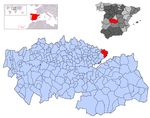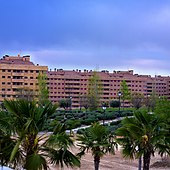Seseña
| Seseña municipality | ||
|---|---|---|
| coat of arms | Map of Spain | |

|
|
|
| Basic data | ||
| Autonomous Community : | Castile-La Mancha | |
| Province : | Toledo | |
| Comarca : | La Sagra | |
| Coordinates | 40 ° 6 ′ N , 3 ° 42 ′ W | |
| Height : | 598 msnm | |
| Area : | 72.68 km² | |
| Residents : | 25,835 (Jan 1, 2019) | |
| Population density : | 355.46 inhabitants / km² | |
| Founding: | 12th Century | |
| Postal code : | 45223 | |
| Municipality number ( INE ): | 45161 | |
| administration | ||
| Mayor : | Carlos Velázquez Romo, PP (since 2011) | |
| Website : | www.ayto-sesena.org | |
| Location of the municipality | ||
Seseña is a city in the province of Toledo , Castile-La Mancha , Spain . It had a population of 25,835 on January 1, 2019. The distance to Toledo is about 51 km, to Madrid just under 48 km. It is almost an enclave surrounded by Madrid.
history
Due to its proximity to irrigated areas, settlement took place here. The area came to the church through donations in the 12th century. The city was populated in the middle of the 15th century.
Civil war
At the Battle of Seseña in 1936 during the Spanish Civil War , after months of fighting, most of the buildings were partially or completely destroyed and the area was conquered by the right-wing coup plotters of Franquism . It was therefore decided to build Seseña Nuevo (4 km from Seseña).
Various sources say that the company of Capitán Paul Arman in Seseña during the Spanish Civil War (1936-1939) defeated two brigades of republican infantrymen in the Battle of Brunete by using incendiary bottles, now known as Molotov cocktails , against the Russian T-26 tanks supported by the Italians and Spanish nationalists. Previously, this weaponry was only used in the civil and intervention wars in Russia (1918–1922), verifiable from sources.
Residencial Francisco Hernando
During the period of the real estate boom up to 2007, the Residencial Francisco Hernando on the El Quiñón site with 13,500 apartments and complete infrastructure was planned primarily as a speculative property, of which only 5,122 apartments were completed. It is named after the entrepreneur Francisco Hernando , also known by the nickname Paco el Pocero , who moved to Equatorial Guinea in 2009 and planned a residential project with 36,000 apartments there without success.
Partly because of the high unemployment rate, the expected demand failed to materialize and the almost uninhabited part of the city looked like a ghost settlement. In 2008, the number of residents in the district was given as only around 750. The reason was the lack of water and electricity. The expansion of the satellite settlement was temporarily suspended, as was the expansion of the necessary transport links.
In the following years, the apartments were offered by the owners for well below the speculative price.
In 2017, around 12,900 people lived in the satellite district. In 2018, the settlement recovered from the consequences of the real estate crisis. The rental had risen to 95% of the portfolio, schools, supermarkets, bakeries, restaurants and other service facilities were opened. A public bus connects the settlement with Madrid every hour.
Although his parents could only offer him a childhood in extreme poverty, Hernando had them put up an oversized statue in the satellite city.
Major fire
In May 2016, a district with around 1,000 residents was evacuated due to a fire in the nearby 110,000 m² car tire dump. Helicopters supported the extinguishing work on the illegal landfill, which contained around five million used tires.
Web links
Individual evidence
- ↑ Cifras oficiales de población resultantes de la revisión del Padrón municipal a 1 de enero . Population statistics from the Instituto Nacional de Estadística (population update).
- ↑ http://www.ayto-sesena.org/corporacion.htm
- ↑ Steven Zaloga , Tony Bryan: Spanish Civil War Tanks: The Proving Ground for Blitzkrieg , p. 16.
- ↑ Aude de Tocqueville: Atlas of the lost cities . Frederking & Thaler , Munich 2015, ISBN 978-3-95416-179-9 .
- ↑ Seseña aprueba los proyectos para la luz y el agua en la urbanización de 'El Pocero' elmundo.es , January 9, 2007, accessed on July 5, 2020 (Spanish)
- ↑ Konrad Fischer :: Collapsing shell structures. (No longer available online.) In: sueddeutsche.de . May 21, 2008, archived from the original on May 11, 2009 ; accessed on October 13, 2018 . Info: The archive link was inserted automatically and has not yet been checked. Please check the original and archive link according to the instructions and then remove this notice.
- ↑ dapd: Madrid suburb of Sesena: bombastic building project degenerates into a ghost town. In: welt.de . March 5, 2012, accessed October 13, 2018 .
- ↑ Seseña, de 'ciudad fantasma' a las listas de espera: "El Pocero aquí es un dios" libremercado.com , February 27, 2018, accessed on July 5, 2020 (Spanish)
- ↑ http://orf.at/#/stories/2339372/ Poisonous smoke from tire dump drives out neighbors, May 14, 2016, accessed on May 16, 2016.




